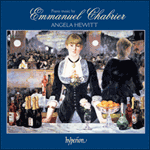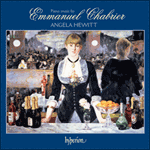There is no need to speculate on the characterization of Chabrier’s
Feuillet d’album. Instructing the artist who was to illustrate the piece when it was first published as a supplement to a magazine in 1890, the composer described it as a ‘blonde and very pale little girl, dreamy and tender; that’s the feeling’. Another Parisienne, or so it seems from the way the slow waltz idiom anticipates Satie’s cabaret songs, she most touchingly equivocates between major and minor. After wandering into a harmonic dream world in the middle section she returns with her melody in octaves—which, as Poulenc observed in his admiring comment on ‘Chabrier’s most tender piece of music’, was one of the older composer’s favourites devices.
from notes by Gerald Larner © 2009
Nul besoin de spéculer sur la peinture de caractère du
Feuillet d’Album de Chabrier, tant ce dernier fut précis dans ses instructions à l’artiste qui devait illustrer l’œuvre pour sa première publication (comme supplément à un magazine, en 1890): «une petite fille blonde et très pâle, rêveuse et attendrie; voilà le sentiment». Parisienne elle aussi, du moins par la manière dont l’idiome de valse lente anticipe les chansons de cabaret de Satie, cette valse équivoque de façon touchante entre majeur et mineur. Après avoir erré en un rêve harmonique dans la section centrale, elle revient avec sa mélodie en octaves—ce qui, comme le remarqua Poulenc dans son admiratif commentaire du «morceau de musique le plus attendrissant de Chabrier», était l’un des procédés préférés de ce compositeur.
extrait des notes rédigées par Gerald Larner © 2009
Français: Hypérion
Es wäre müßig, darüber zu spekulieren, was in Chabriers
Feuillet d’album dargestellt wird. An den Künstler, der das Stück 1890 für die Erstausgabe in der Beilage eines Magazins illustrieren sollte, richtete Chabrier folgende Beschreibung: es handle sich um „ein kleines blondes und sehr blasses Mädchen, träumerisch und sanft; das ist hier der Ausdruck“. Offenbar auch eine Pariserin; den Eindruck vermittelt jedenfalls der langsame Walzerstil, der Saties Kabarett-Lieder vorwegnimmt und sie bewegt sich zweideutig zwischen Dur und Moll hin und her. Nachdem sie sich im Mittelteil in einer harmonischen Traumwelt ergeht, kehrt sie mit ihrer Melodie in Oktaven zurück, was, wie Poulenc anerkennend über „Chabriers sanftestes Musikstück“ bemerkte, ein Lieblingsstilmittel des älteren Komponisten war.
aus dem Begleittext von Gerald Larner © 2009
Deutsch: Viola Scheffel


 Chabrier: Piano Music
Chabrier: Piano Music Chabrier: Piano Music
Chabrier: Piano Music
